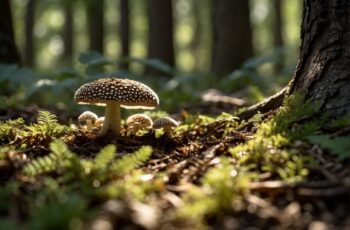If you’re a mushroom enthusiast in Ohio, you’re in luck! Ohio is home to a wide variety of edible mushrooms, including morels, chanterelles, and chicken of the woods. However, it’s important to note that not all mushrooms in Ohio are safe to eat, and proper identification is crucial before consuming any wild mushrooms.
Mushroom hunting and foraging can be a fun and rewarding activity, but it’s important to be aware of the potential risks. Some species of wild mushrooms in Ohio are poisonous and can cause illness or even death if consumed. It’s important to consult a field guide or other resources to properly identify the mushrooms you collect and ensure they are safe to eat.
The Ohio Mushroom Society is a great resource for mushroom enthusiasts in the state. They offer educational events, workshops, and field trips to help members learn more about mushroom identification, collecting, and preparation. Additionally, there are several books and online resources available to help you properly identify and prepare wild edibles. Remember, proper identification is key when it comes to foraging for mushrooms in Ohio.
Edible Mushrooms in Ohio
If you are a fan of foraging and looking for some edible mushrooms in Ohio, you are in luck. Ohio is home to a wide variety of edible mushroom species that can be found in different habitats, including meadows, fields, and forest floors.
One of the most popular edible mushrooms in Ohio is the brown or shaggy mane mushroom. This mushroom has a unique appearance with its long, shaggy cap and is commonly found in open fields and meadows. Another popular species is the chanterelle mushroom, which has a golden color and an earthy flavor.
When collecting wild mushrooms, it is important to properly identify them to avoid any potential health risks. The Ohio Mushroom Society is a great resource for mushroom hunting enthusiasts. They offer field guides, publications, and even mushroom club meetings where you can learn more about wild edibles and proper identification techniques.
Other edible mushroom species found in Ohio include the honeycomb mushroom, meadow mushroom, shaggy parasol, giant puffball mushroom, and more. It is important to note that some species, such as the false parasol, can be mistaken for edible mushrooms but are actually poisonous.
If you are new to mushroom hunting, it is recommended to start with easily identifiable species such as the puffball mushroom or the agaricus campestris, also known as the meadow mushroom. These species have a mild flavor and can be sautéed or added to soups and stews.
For more experienced foragers, the giant puffball mushroom and the golden chanterelle are highly sought after for their unique flavor and texture. The shiitake mushroom is also a popular choice for its meaty and savory taste.
Once you have collected your mushrooms, it is important to properly prepare them. Some species, such as the shaggy mane and the coprinus comatus, have a short shelf life and should be consumed soon after collecting. Others, such as the giant puffball and the chlorophyllum rachodes, can be parboiled, dried, or pickled for later use.
In conclusion, Ohio is a great place for mushroom hunting enthusiasts with its temperate climate and diverse habitats. With proper identification and preparation, you can enjoy a variety of delicious and nutritious wild edibles. So, grab your field guide and start exploring the world of edible mushrooms in Ohio!
Identifying Edible Mushrooms
Mushroom hunting in Ohio can be a fun and rewarding activity, but it is important to know how to identify edible mushrooms correctly. Proper identification is crucial because some wild mushrooms can be toxic or deadly. Here are some tips to help you identify edible mushrooms in Ohio.
Field Guide and Mushroom Club
Before you start mushroom hunting, it is recommended that you purchase a field guide or join a mushroom club like The Ohio Mushroom Society. These resources can help you learn about different species, habitats, and edibility. They can also provide you with valuable information about collecting and preparing wild edibles.
Habitat and Environment
Different species of mushrooms grow in different environments and habitats. For example, shaggy manes and meadow mushrooms can be found in meadows and fields, while chanterelles grow in hardwoods. Knowing the habitat and environment of a mushroom can help you identify it correctly.
Physical Characteristics
Physical characteristics such as color, shape, and texture can also help identify mushrooms. For example, shaggy parasols have a brown cap with white scales, while the meadow mushroom has a smooth white cap. The shaggy mane mushroom has a shaggy cap that turns black as it ages. Puffballs and giant puffballs are round with no stem and can be quite large.
Spore Prints
Making a spore print is another way to identify mushrooms. To make a spore print, cut off the stem of the mushroom and place the cap gill-side down on a piece of white paper. Cover it with a bowl or jar and leave it overnight. The spores will drop onto the paper and create a pattern that can help identify the mushroom.
Edibility
It is important to note that not all wild mushrooms are edible. Some can be toxic or deadly, while others can cause mild symptoms like nausea or vomiting. Always be sure to properly identify a mushroom before consuming it. Some edible mushrooms in Ohio include chanterelles, shiitake, shaggy manes, and portobellos. They have an earthy flavor and can be sautéed or added to soups and stews.
Proper Preparation
When collecting wild mushrooms, it is important to properly prepare them before consuming them. This can include parboiling, drying, or pickling. Some mushrooms like the false parasol and the rachodes mushroom can cause a bitter taste if not prepared properly.
In conclusion, identifying edible mushrooms in Ohio can be a fun and rewarding activity. By following these tips, you can safely collect and prepare wild edibles for a delicious meal. Remember to always properly identify a mushroom before consuming it and to use caution when collecting wild mushrooms.
Poisonous Mushrooms in Ohio
If you’re an avid mushroom hunter in Ohio, it’s important to be aware of the poisonous mushrooms that grow in the area. While most wild mushrooms are safe to eat, there are a few species that can be deadly if ingested.
One of the most dangerous mushrooms found in Ohio is the false morel. This mushroom is often mistaken for the edible morel, but it contains a toxin that can cause serious illness or death. The false morel has a wrinkled cap that is usually brown or reddish-brown in color.
Another poisonous mushroom found in Ohio is the shaggy mane. While this mushroom is not deadly, it can cause illness if consumed raw. The shaggy mane has a distinctive appearance, with a tall, thin stem and a cap that looks like shaggy fur. It is usually found in meadows and fields.
The honeycomb mushroom is another poisonous species found in Ohio. This mushroom has a distinctive appearance, with a cap that looks like a honeycomb. It is usually brown in color and can be found growing on dead trees or logs.
It’s important to remember that not all poisonous mushrooms in Ohio are easy to identify. Some species, like the brown and shaggy parasol mushrooms, can be difficult to distinguish from edible mushrooms. To ensure your safety, it’s essential to use a field guide and proper identification techniques when collecting wild edibles.
If you’re interested in learning more about mushrooms in Ohio, consider joining the Ohio Mushroom Society. This organization provides resources and information on mushroom hunting, identification, and edibility. Additionally, there are many books available on the subject that can help you become a more knowledgeable mushroom hunter.
Remember, when it comes to mushroom hunting in Ohio, safety should always be your top priority. Always properly identify any wild mushrooms you collect, and never consume any mushrooms that you are not completely sure are safe to eat.


